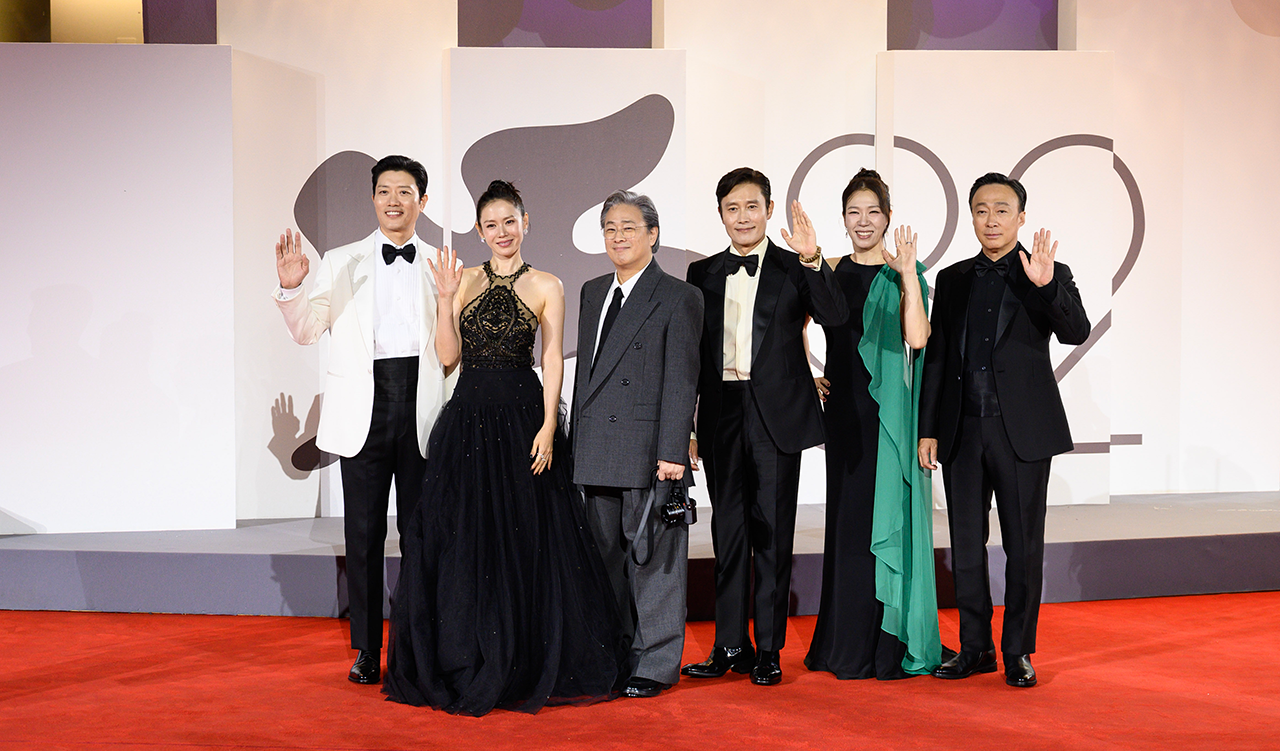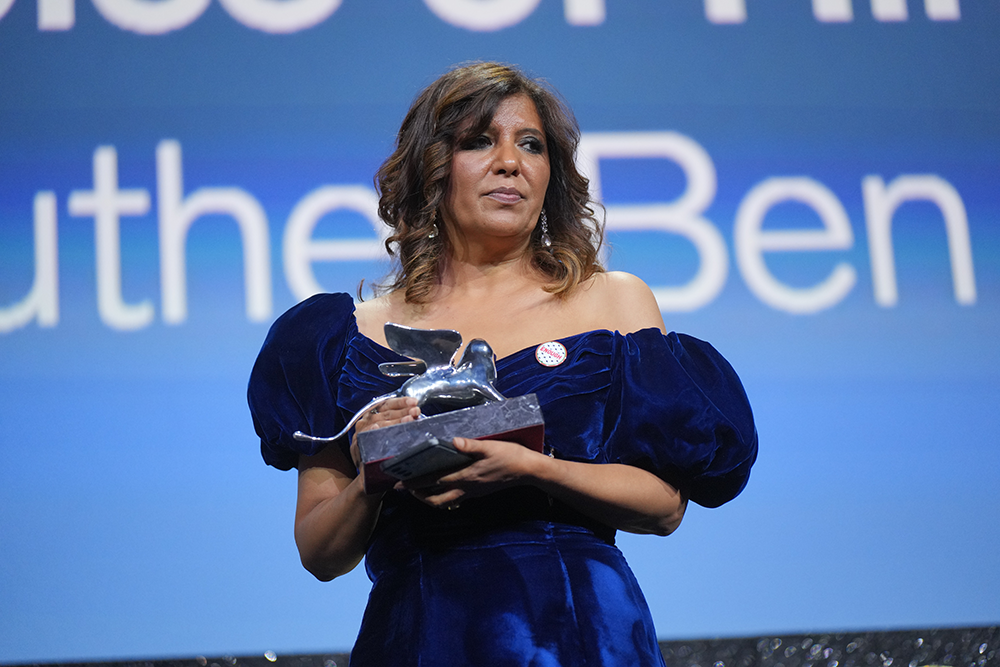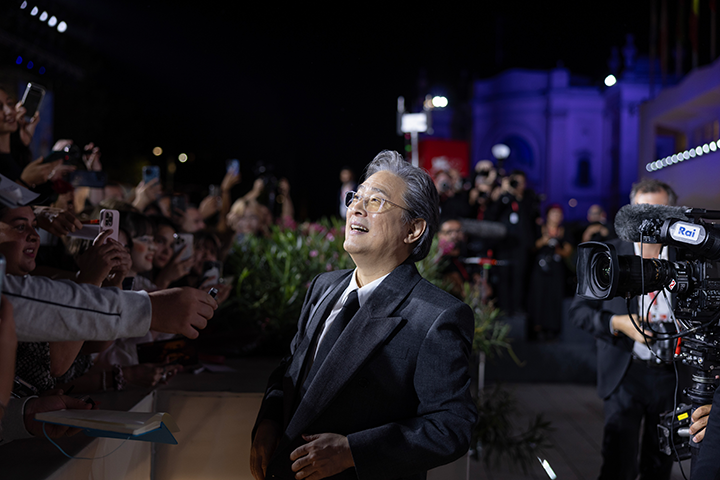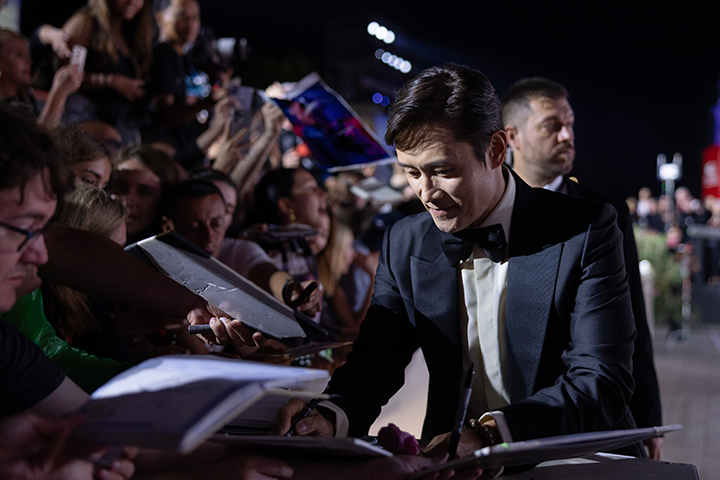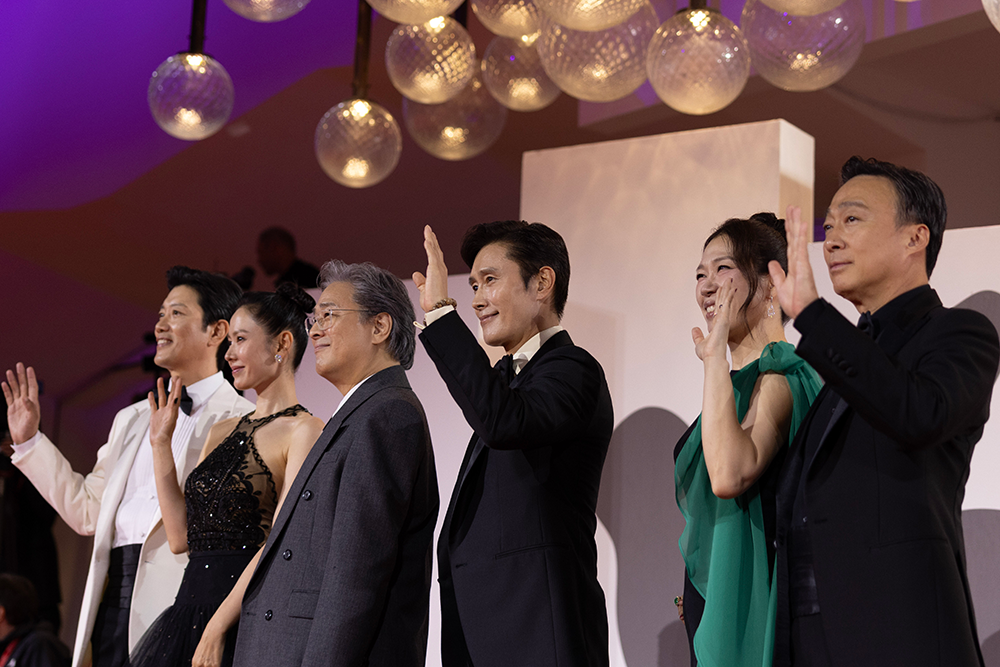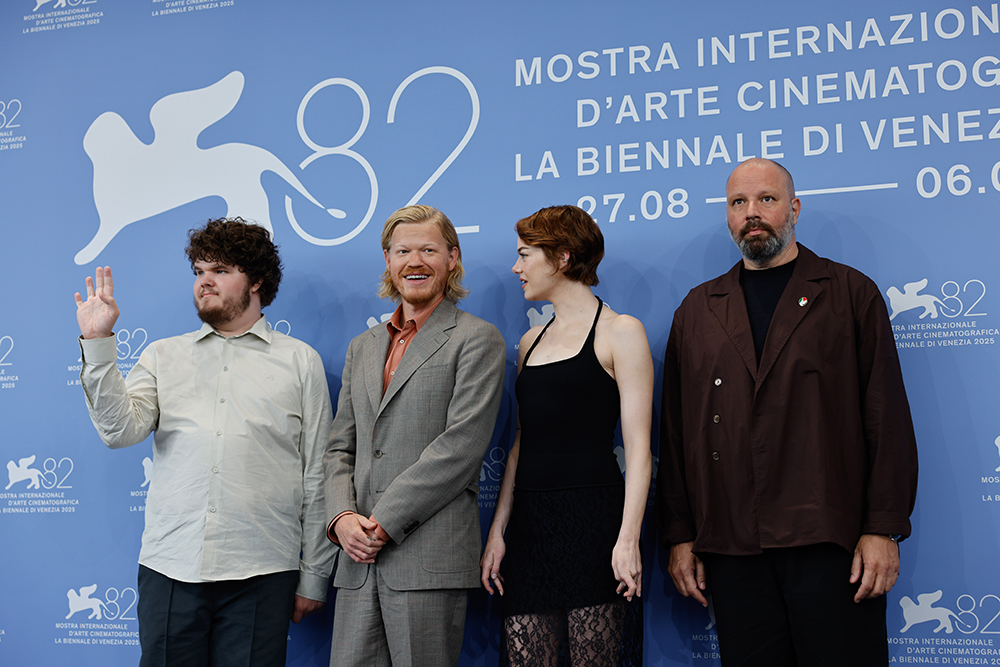아드리아해에 흩뿌리던 비가 멎고 태양이 다시 고개를 내민다. 8월 말 베네치아(베니스)는 분주하다. 로마광장에서 종착역인 리도섬까지 가는 바포레토(수상버스)는 발 디딜 틈이 없다. 산마르코광장 등 정류장을 하나씩 거칠수록 편한 차림의 관광객은 하나둘 사라진다. 끝까지 한배를 타는 건 턱시도와 드레스 차림의 사람들, 한 손엔 수첩을 들고 어깨에는 카메라를 멘 기자들, 그리고 어디선가 건너온 영화학도들이다. 흔들리는 수면을 건너 이들이 향하는 곳은 ‘팔라초 델 치네마(영화의 전당)’. 세계에서 가장 오래된 영화제인 ‘베니스국제영화제’의 심장이다. 지난 8월 27일 개막해 11일간 펼쳐진 82회 베니스국제영화제(이하 베니스영화제) 현장을 찾았다.
오스카 전초전이 된 베니스영화제
한때 세상에서 가장 부유했던 도시. 찬란했던 베네치아의 영광은 이제 흔적만 남았다. 하지만 황금이 남기고 간 불씨는 꺼지지 않았다. 지금 이 도시는 문화와 예술이 지탱한다. ‘베네치아 비엔날레’라는 이름으로 미술, 건축, 무용, 음악, 연극, 그리고 영화라는 여섯 장르의 예술 축제가 ‘물 위의 도시(La città sull’acqua)’를 떠받치고 있다. 그리고 8월과 9월에 가장 빛나는 기둥은 단연 영화다. 베니스영화제는 매년 이 시기, 리도섬을 전 세계가 주목하는 영화예술의 메카로 변모시킨다. 국제영화제작자연맹(FIAPF)이 공인한 국제영화제는 현재 27개국 44개. 1932년 시작한 베니스영화제는 이 중에서도 가장 오랜 역사를 지니고 있다. 수많은 영화제가 명멸하는 와중에도 명맥을 이어왔다. 부침이 없던 건 아니다. 어느 순간 베니스는 상업성과 대중성을 품으며 ‘만국 영화 박람회’가 된 칸국제영화제의 스포트라이트를 바라보는 위치에서 자존심을 구겼다. 현격했던 차이는 최근 들어 다시 좁혀지고 있다.
실마리는 예술과 대중을 잇는 베니스의 세련된 안목에 있었다. “베니스는 오스카(미국 아카데미 시상식)의 포문을 여는 시작점”(고경범 CJ ENM 글로벌프로젝트담당·영화 <부고니아> 공동 제작자)이라는 한 마디가 글로벌 영화계에서 베니스의 중요성을 잘 드러낸다. 그 말처럼 지난 4년 새 베니스영화제 경쟁·비경쟁 부문에 소개된 작품 중 90여 개가 오스카 후보에 올랐고, 상당수가 트로피까지 거머쥐는 등 베니스는 시상식 시즌의 전초 무대가 되었다. 2018년 알폰소 쿠아론의 <로마>에 황금사자상을 안기는 등 칸이 극장 상영 규정을 앞세워 온라인동영상서비스(OTT) 영화를 초청 대상에서 배제할 때, 넷플릭스 등에서 공개된 수준급 OTT 영화들을 품은 예리한 감각도 황금사자가 회춘한 비결이다.
오스카 시즌에 주목받을 영화들을 미리 알아볼 수 있는 베니스영화제
(제공=Jacopo Salvi, 베니스국제영화제. ASAC)
짐 자무시, 박찬욱, 그리고 벤 하니야
좋은 영화, 훌륭한 감독과 배우, 그리고 관객으로 함께하는 시네필(Cinephile, 영화 애호가)들. 전 세계 이름난 도시에서 열리는 수많은 영화제의 성공 방정식을 요약하면 이렇다. 이런 맥락에서 올해 베니스의 위상은 한층 높아졌다. 올해 리도섬에 모인 작품들을 통해 세계 영화계의 흐름을 가늠할 수 있을 만큼 풍요로웠기 때문이다. 82회를 맞은 올해 베니스영화제는 단단한 균형감을 보여줬다. 거장 감독과 넷플릭스가 함께 귀환했고, 미래지향적 시각에서 영화적 담론을 만들어내면서다. 사회적 의제를 건드리는 작품과 실험적 시도 역시 골고루 배치되었다. 리도섬에서 마주친 현지 영화계 관계자는 이런 말을 남겼다. “세계에서 가장 오래된 국제영화제가 되었다는 건 결국은 가장 먼저 영화라는 예술의 가치를 알아봤기 때문이 아닐까요. 여긴 늘 새로워요.”
올해 경쟁 부문에 올라 황금사자상을 놓고 다툰 21편의 작품 큐레이팅이 이를 단적으로 보여준다. 가장 눈에 띄는 건 진정한 장편영화의 귀환이다. 라즐로 네메즈의 <나의 이름은>이 132분에 달하는 등 2시간이 넘는 러닝 타임의 영화들이 7편이나 이름을 올렸다. 유튜브발 ‘숏폼’ 열풍이 휘몰아치며 긴 이야기는 하품 나오는 옛날 콘텐츠란 인식이 커지는 가운데 베니스는 ‘영화다운 영화’를 강조한 것이다. 영화라는 예술 매체가 갖는 다양한 장르적 경험도 중시했다. 공상과학(SF)에 블랙코미디를 더한 요르고스 란티모스의 <부고니아>부터 기예르모 델 토로의 판타지 호러 <프랑켄슈타인>, 앤솔로지(3부작) 드라마인 짐 자무시의 <파더 마더 시스터 브라더>, 현실을 고발하는 다큐멘터리인 카우타르 벤 하니야의 <힌드의 목소리>, 올리비에 아사야스의 정치 스릴러 <크렘린의 마법사> 등 유행을 타지 않고 감독 본연의 미학과 영화적 고민을 느낄 수 있는 다채로운 장르의 작품들이 초청되었다.
올해 영화제의 경쟁 부문 수상 결과에선 세계 영화계가 어디를 바라보고 있는지에 대한 징후가 읽힌다. 짐 자무시의 황금사자상 수상은 ‘깜짝 수상’으로 주목받는다. 박찬욱의 <어쩔수가없다>와 벤 하니야의 <힌드의 목소리>가 영화제 기간 가장 유력한 후보로 불렸지만, 그렇다고 짐 자무시의 수상이 크게 이해하지 못할 만한 것은 아니다. 늘 그랬듯 베니스는 영화의 예술적 가치를 주목해 왔기 때문. 올해 경쟁 부문 심사위원장을 맡은 알렉산더 페인이 일상에 휴머니즘을 녹여내는 시각을 견지하고 있다는 점에서 가족 간의 감정적 단절을 담담하게 조명한 <파더 마더 시스터 브라더>는 비슷한 맥락을 보여준다. 베니스는 반드시 전쟁 등 거대한 사건을 다룬 정치적 영화만이 시대를 기록하는 게 아니란 점을 황금사자상 수상으로 드러낸 것이다. 자주색 정장에 까만 선글라스를 낀 채 단상에 오른 자무시 역시 “예술은 정치적이기 위해 정치를 직접 다룰 필요는 없다”며 “사람들 사이의 공감과 연결을 만드는 것이 문제 해결의 첫걸음”이라고 강조했다.
<파더 마더 시스터 브라더>로 황금사자상을 거머쥔 짐 자무시 감독
(제공=Andrea Avezz, 베니스국제영화제. ASAC)
황금사자상의 이변보다 주목해야 할 점은 베니스가 2등상 격인 심사위원대상(은사자상)에 결국 정치적 메시지가 분명한 <힌드의 목소리>를 올렸다는 것이다. 앞서 칸국제영화제가 이란 영화감독 자파르 파나히의 <그저 사고였을 뿐>에 최고상인 황금종려상을 준 것처럼, 영화라는 예술이 미학만큼 사회적 증언을 기록하고 시대적 아픔을 발화하는 장(場)의 역할을 하겠다는 의도가 읽힌다. 오스카로 가는 출발점인 베니스에서 이스라엘과 밀접한 할리우드가 꺼릴 만한 이 작품을 2등상에 선정했다는 자체가 의미 있는 것이다. 할리우드 스타 브래드 피트, 호아킨 피닉스, 알폰소 쿠아론 등이 공동 제작자로 참여한 이 영화는 지난해 이스라엘군의 공습으로 목숨을 잃은 가자지구 소녀 힌드 라잡의 실화를 바탕으로 재구성한 다큐멘터리 드라마다. 베니스에서 상영될 당시 무려 23분에 달하는 기립박수를 받으며 화제를 낳았다.
이 밖에 이탈리아 영화감독 지안프랑코 로시의 <구름 아래>에 심사위원특별상을, 프랑스 영화감독 발레리 동젤리의 <앳 워크>에 각본상을 쥐어준 결정도 납득이 가는 결정이다. 볼피컵으로 불리는 남녀주연상은 각각 이탈리아 국민 배우인 토니 세브릴로(<라 그라치아>), 중국 배우 신즈레이(<우리 머리 위의 태양>)가 받았다. 다만 베니 사프디의 <더 스매싱 머신>이 받은 감독상은 밋밋한 전개로 영화제 기간 중 좋은 평가를 받지 못한 터라 ‘옥의 티’로도 꼽힌다.
황금사자상 유력 후보였던 카우타르 벤 하니야 감독의
<힌드의 목소리>는 심사위원대상을 받았다
(제공=Andrea Avezz, 베니스국제영화제. ASAC)
<어쩔수가없다>, 독보적인 존재감
올해 리도섬엔 수작들이 무더기로 쏟아졌지만, 이 중에서도 돋보이는 건 단연 한국영화였다. ‘미장센의 대가’ 박찬욱이 배우 이병헌, 손예진 등 동방의 별을 이끌고 등장해 신작 <어쩔수가없다>로 20년 만에 황금사자상 쟁탈전에 도전장을 내밀면서다. 코로나19 팬데믹 이후 부침을 겪으며 시장이 존폐의 기로에 섰다는 위기론까지 대두된 한국영화계에 있어 오랜만에 단비 같은 소식이라 일찌감치 국내에서도 주목받았다. 특히 ‘깐느 박’으로 불릴 만큼 칸에서 독보적인 존재감을 보였던 박찬욱 감독이 막판 후반작업 등을 이유로 칸을 건너뛰고 베니스를 찾았다는 데서 이목이 집중되었다. 베니스는 고(故) 김기덕 감독이 2012년 <피에타>로 황금사자상을 받은 뒤론 한국영화와 인연이 드문 영화제였기 때문이다.
실제로 <힌드의 목소리>가 영화제 후반부 분위기를 주도했다면 <어쩔수가없다>는 영화제 초반을 달군 작품으로 거론되었다. 무엇보다 유수의 작품을 제치고 영화제 프라임 타임으로 불리는 첫 주 금요일 밤 황금시간대인 지난 8월 28일 월드 프리미어(세계 첫 공개) 공식 상영이 잡혔다는 점에서 최고의 화제성을 보여줬다. 상영시간이 수상 여부를 결정하는 것은 아니지만, 전 세계 언론과 영화 산업 관계자, 애호가들이 가장 주목하는 시간에 상영시간표를 짰다는 것은 베니스가 올해 전면에 내세우는 작품임을 보여주는 시그널이기 때문이다. 실제로 2023년 요르고스 란티모스의 <가여운 것들>이 영화제 금요일 프라임 타임에 프리미어 상영으로 공개되었고, 그해 황금사자상을 받은 바 있다.
베니스영화제 프라임 타임에 공개된 <어쩔수가없다>
월드 프리미어 현장에서
수많은 팬을 반기는 박찬욱 감독과 이병헌(제공=Jacopo Salvi, 베니스국제영화제. ASAC)
한국영화는 K-팝과 함께 세계로 뻗어 나간 한류의 첫 번째 파도로 주목받았지만, 최근 들어선 홀로 내리막길을 걷고 있다는 우려를 샀다. 2019년 봉준호 감독의 <기생충>이 황금종려상을 받은 이후 국제영화제에서 별다른 성과를 내지 못했기 때문이다. 관객이 오지 않는 극장의 현실이 2000년대 ‘한국영화 르네상스’ 이후 지속된 특유의 K-무비 작품성까지 떨어뜨리고 있다는 위기감도 커졌다. <오징어 게임> 시리즈나 <케이팝 데몬 헌터스> 같은 작품들이 전 세계를 휩쓸었지만, 넷플릭스의 오리지널 작품이란 점에서 온전히 한국영화의 성과라고 보기엔 무리가 있는 것도 사실이다.
팔라초 델 치네마에서 진행된 <어쩔수가없다> 월드 프리미어 상영 현장은 ‘K-무비’가 여전히 저력을 갖고, 세계적으로 인정받고 있음을 보여주는 무대였다. 오후 9시 45분부터 영화제 메인 상영관인 ‘살라 그란데’에서 진행되는 시사회를 앞두고 정장과 드레스를 차려입은 인파로 리도섬이 붐비기 시작한 것. 이날 한때 비바람이 몰아치기도 했지만, 이른 시간부터 극장 바깥은 영화 팬들이 몰려 인산인해를 이뤘다. 이들은 영화 상영을 앞두고 박찬욱 감독을 포함한 <어쩔수가없다> 사단이 레드카펫에 등장하자 환호를 질렀다. 일부 팬들은 주연배우인 이병헌을 향해 “리(Lee)!”라고 외치며 사인을 요구해 주위를 놀라게 했다. 워낙 열기가 뜨거웠던 탓에 영화 상영은 당초 예정되었던 시간을 훌쩍 넘겨서야 시작했다.
백미는 자정을 넘겨 영화의 엔딩 크레디트가 올라간 순간이다. 1천 명이 넘는 관객들이 일제히 일어나 2층 객석에 자리 잡은 박찬욱 감독과 배우들에게 기립박수를 터뜨린 것. 환호와 박수는 9분 가까이 이어졌다. 이날 한 관객이 상기된 목소리로 “기대 이상으로 흥미로웠다”며 “사회가 만들어낸 괴물을 잘 표현했다”고 말했고, 미국 연예 매체 버라이어티는 “박찬욱이 현존하는 가장 품위 있는 감독이라는 것을 보여주는 결정적 증거이자 매혹적인 블랙 코미디”라고 보도하기도 했다.
<어쩔수가없다>는 베니스영화제에서 호평을 얻으며 K-무비의 저력을 보여줬다
(제공=Jacopo Salvi, 베니스국제영화제. ASAC)
<부고니아>로 확인한 한국영화의 활로
한국영화의 저력은 함께 경쟁 부문에 오른 영화 <부고니아>를 통해서도 드러났다. CJ ENM이 기획개발을 주도해 할리우드 유명 감독인 아리 애스터가 제작하고 요르고스 란티모스가 자신의 페르소나인 엠마 스톤을 내세워 연출한 이 영화는 2003년 개봉한 한국영화 <지구를 지켜라!>를 리메이크했다. 개봉 당시 흥행엔 참패했지만 신선한 작품성과 상상력 하나만큼은 인정받았던 영화가 20여 년 만에 할리우드에서 다시 태어난 것이다. 영화제 기간 중 만난 고경범 CJ ENM 글로벌프로젝트담당은 <지구를 지켜라!>가 리메이크 되고, 올해 베니스영화제 경쟁 부문에 초청된 의미를 이렇게 말했다. “<지구를 지켜라!>는 봉준호와 박찬욱이 등장한 ‘한국영화 르네상스’ 시기에 나온 상상력입니다. 이걸 리메이크한 <부고니아>는 그 상상력이 지금도 세계 영화 시장에서 유효하다는 걸 보여준다고 봐요. 이런 맥락에서 이 영화가 <어쩔수가없다>와 함께 베니스에 초청받은 건 상징적인 사건이죠.”
<부고니아>는 위기에 빠진 한국영화 산업에 새로운 활로를 던졌다는 평가다. 투자 경색으로 신작 제작이 멈춘 충무로에 한국영화 지식재산권(IP)으로 새로운 수익을 창출할 수 있다는 메시지를 던졌기 때문이다. K-콘텐츠가 세계적인 주류 문화 트렌드로 자리 잡은 시점에서, 한국적인 상상력과 스토리가 글로벌 소구력을 갖추고 있다는 것이다. 더 이상 한국영화계가 오직 한국 시장만 바라보고 작품을 만들어선 안 된다는 시그널을 보여준 셈이기도 하다. 영화제 기자회견에서 만난 요르고스 란티모스 감독은 “시나리오를 읽자마자 바로 반응이 왔다”며 “조금씩 시나리오를 흔들어보며 상상했던 것과 맞춰 나갔는데, 정말 강렬했던 여정”이라고 말했다.
베니스영화제가 폐막한 뒤 국내에선 <어쩔수가없다>의 황금사자상 수상 불발에 아쉬운 기색을 드러낸다. 영화제 현장을 다녀온 입장에선 아쉬움보다는 기대감이 크다. <어쩔수가없다>에 대한 찬사, 한국영화 IP를 활용한 <부고니아>의 선전은 한국영화가 여전히 세계영화계 주류 담론의 한복판에서 설득력을 갖고 있음을 확인시켜주었기 때문이다. 베네치아 본섬과 리도섬을 가로지르는 물 위를 건너며 일정을 챙긴 불편함조차 한국영화사의 한 페이지를 목격한 대가로 기꺼이 치를 만한 통행세처럼 느껴졌다. 베니스영화제는 막을 내렸고 극장가는 여전히 보릿고개를 넘고 있지만 그래도 한국영화에 대한 낙관적인 상상은 어쩔 수가 없다.
<지구를 지켜라!>의 할리우드 리메이크 <부고니아>는 한국영화의 상상력과 스토리가 전 세계에서 통할 수 있다는 걸 보여줬다.
사진은 요르고스 란티모스 감독(맨 오른쪽)과 출연진
(제공=Andrea Avezz, 베니스국제영화제. ASAC)
베니스국제영화제
한국영화
어쩔수가없다
박찬욱감독
이병헌
해외영화제
국제영화제
부고니아
GLOBAL ②
The Return of “True Cinema”
Scenes from the 82nd Venice International Film Festival
By Yoo Seung-mok (Culture Desk Reporter, Korea Economic Daily)
2025-09-15
(Photo by Aleksander Kalka, Venice International Film Festival / ASAC)
(Photo by Aleksander Kalka,
Venice International Film Festival / ASAC)
The rain that had scattered across the Adriatic comes to a halt, and the sun peers out once more. Late August in Venice is bustling. The vaporetto, the water bus running from Piazzale Roma to its final stop on Lido Island, is so crowded there is hardly any room to stand. With each stop—San Marco Square and others—casually dressed tourists gradually disappear. Those who remain until the end are clad in tuxedos and gowns, journalists with notebooks in hand and cameras slung over their shoulders, and film students who seem to have come from far away. Crossing the rippling waters, they head toward the Palazzo del Cinema—the Hall of Film. It is the very heart of the Venice International Film Festival, the world’s oldest film festival. On August 27, the 82nd festival opened and unfolded over eleven days, and I was there to witness it.
Venice Film Festival: The Prelude to the Oscars
Once the wealthiest city in the world, Venice now retains only traces of its former splendor. Yet the spark of its golden age has not gone out. Today, the city is sustained by culture and the arts. Under the banner of the Venice Biennale, six artistic festivals—visual arts, architecture, dance, music, theater, and film—support this “City on the Water” (La città sull’acqua ). And in August and September, it is cinema that shines the brightest. Each year, the Venice Film Festival transforms the Lido into a mecca of cinematic art that captures the world’s attention. Of the 44 international film festivals in 27 countries accredited by the International Federation of Film Producers Associations (FIAPF), Venice, founded in 1932, is the oldest. Despite the rise and fall of countless festivals, it has endured. That is not to say it has been free of setbacks. There was a time when Venice’s pride was wounded, reduced to watching the spotlight shift toward Cannes—a festival that embraced commercialism and popular appeal to become the “world exposition of cinema.” Yet in recent years, that once-gaping divide has begun to narrow again.
The key lies in Venice’s refined ability to bridge art and the public. As Ko Kyung-bum, Head of Global Projects at CJ ENM and co-producer of Bugonia , put it, “Venice is the starting point that opens the gates to the Oscars.” That single remark encapsulates the festival’s importance in the global film world. Indeed, over the past four years, some 90 films introduced in both competition and non-competition sections at Venice have gone on to become Oscar nominees, with many capturing trophies—cementing the festival as a prelude to awards season. While Cannes excluded streaming titles by enforcing its theatrical screening rule, Venice, by contrast, displayed a sharp sensibility in embracing high-caliber OTT films. Decisions such as awarding the Golden Lion in 2018 to Alfonso Cuarón’s Roma, released on Netflix, were key to revitalizing the prestige of this award.
The Venice Film Festival offers a preview of films likely to attract attention during the Oscar season.
(Photo by Jacopo Salvi, Venice International Film Festival / ASAC)
Jim Jarmusch, Park Chan-wook, and Kaouther Ben Hania
Good films, great directors and actors, and cinephiles—the devoted audiences who share in the experience. This, in essence, is the formula behind the success of countless film festivals in renowned cities around the world. In this light, Venice’s standing rose even higher this year, as the lineup that gathered at the Lido was so abundant it offered a glimpse into the currents of world cinema. Marking its 82nd edition, the Venice Film Festival demonstrated a firm sense of balance. Legendary directors returned alongside Netflix, while forward-looking perspectives sparked new cinematic discourse. Socially engaged works and experimental endeavors were also evenly represented. As one local film industry figure I met on the Lido remarked, “Perhaps the reason Venice has become the world’s oldest international film festival is because it was the first to recognize the true value of cinema as an art form. Here, it always feels new.”
The curation of the 21 films in this year’s Golden Lion competition speaks volumes. Most striking was the return of true feature-length cinema. Seven entries, including László Nemes’s Árva with a running time of 132 minutes, exceeded the two-hour mark. In an era swept by the craze for YouTube-driven short-form content—where long narratives are often dismissed as outdated and dull—Venice boldly reaffirmed the value of “true cinema.” The festival also showcased the breadth of genre experiences unique to film as an art form. From Yorgos Lanthimos’s Bugonia , blending science fiction with black comedy, to Guillermo del Toro’s fantasy-horror Frankenstein , Jim Jarmusch’s three-part anthology drama Father Mother Sister Brother , Kaouther Ben Hania’s reality-exposing documentary The Voice of Hind Rajab , and Olivier Assayas’s political thriller The Wizard of the Kremlin , the lineup presented works that resisted trends, each grounded in its director’s distinct aesthetics and cinematic concerns.
The results of this year’s competition hint at where the global film industry’s gaze is turning. Jim Jarmusch’s Golden Lion win was seen by many as a “surprise victory.” While Park Chan-wook’s No Other Choice and Kaouther Ben Hania’s The Voice of Hind Rajab were widely considered frontrunners, Jarmusch’s triumph is by no means inexplicable. As always, Venice remained attentive to the artistic value of cinema. This year’s jury president, Alexander Payne, is known for weaving humanism into everyday life, and in that sense Jarmusch’s Father Mother Sister Brother , a quiet portrayal of emotional estrangement within families, aligned with his vision. The award reaffirmed Venice’s belief that films need not focus solely on wars or grand political events to serve as chronicles of their times. Wearing a purple suit and black sunglasses as he took the stage, Jarmusch underscored the point himself: “Art does not need to deal with politics directly in order to be political,” he said. “Creating empathy and connection among people is the first step toward solving problems.”
Jim Jarmusch took home the Golden Lion with Father Mother Sister Brother.
(Photo by Andrea Avezz, Venice International Film Festival / ASAC)
More significant than the upset in the Golden Lion race was Venice’s decision to award its second-highest honor, the Grand Jury Prize, to The Voice of Hind Rajab, a film with an unmistakably political message. Much like Cannes did when it granted its top prize, the Palme d’Or, to Iranian director Jafar Panahi’s It Was Just an Accident, Venice signaled that it views cinema not only as an aesthetic pursuit but also as a forum for social testimony and a medium for articulating the pains of the times. That Venice—the traditional starting point for the road to the Oscars—chose to honor a work likely to unsettle Hollywood, given its ties to Israel, with the second prize is itself a meaningful gesture. Co-produced by Hollywood figures such as Brad Pitt, Joaquin Phoenix, and Alfonso Cuarón, the film reconstructs in docudrama form the true story of Hind Rajab, a young girl killed in last year’s Israeli airstrikes on Gaza. At its Venice screening, the film drew a 23-minute standing ovation, sparking widespread attention.
Equally persuasive were the jury’s choices to give the Special Jury Prize to Gianfranco Rosi’s Below the Clouds and the Best Screenplay honor to Valérie Donzelli’s At Work. The Volpi Cups for Best Actor and Best Actress went to Italian national treasure Toni Servillo for La Grazia and Chinese actress Xin Zhilei for The Sun Rises on Us All. The Best Director award to Benny Safdie’s The Smashing Machine, however, was seen as a blemish, as the film’s flat narrative had not been well received during the festival.
Regarded as a frontrunner for the Golden Lion,
Kaouther Ben Hania’s The Voice of Hind Rajab ultimately received the Grand Jury Prize.
(Photo by Andrea Avezz, Venice International Film Festival / ASAC)
No Other Choice, An Unmistakable Presence
Even though many outstanding works premiered on the Lido this year, it was Korean cinema that stood out most. Park Chan-wook, the “master of mise-en-scène,” arrived with stars including Lee Byung-hun and Son Ye-jin to contend for the Golden Lion with his new film No Other Choice, marking his return to Venice after twenty years. For the Korean film industry—long beset by debates over its survival amid turbulence following the COVID pandemic—this was welcome news, quickly drawing attention back home. Particularly striking was the fact that Park, often dubbed “Cannes Park” for his singular presence at that festival, skipped Cannes this year, citing final post-production work, and instead brought his film to Venice. The move carried added significance, as Korean cinema had had little connection with Venice since the late Kim Ki-duk won the Golden Lion in 2012 with Pieta.
If The Voice of Hind Rajab dominated the festival’s tone during the latter half, No Other Choice electrified the opening days. Above all, it became the talk of Venice when it edged out prominent contenders to secure the festival’s coveted “prime time” slot—the official world premiere screening on Friday night, August 28. While screening times do not determine award outcomes, being scheduled in the time most closely watched by global media, industry professionals, and cinephiles signaled that Venice intended to spotlight the film as one of its centerpiece selections this year. Indeed, in 2023, Yorgos Lanthimos’s Poor Things premiered in the same Friday prime-time slot and went on to win the Golden Lion.
At the world premiere of No Other Choice , unveiled in Venice’s coveted prime-time slot,
director Park Chan-wook and actor Lee Byung-hun greet a crowd of fans.
(Photo by Jacopo Salvi, Venice International Film Festival / ASAC)
Korean cinema, once hailed as the first wave of the Korean Wave alongside K-pop, has more recently drawn concern for its apparent decline. Since Bong Joon-ho’s Parasite won the Palme d’Or in 2019, Korean films have struggled to achieve notable results at major international festivals. Growing concern also surrounds the reality that audiences drifting away from theaters may be undermining the distinctive artistry of K-movies that continued after the “Korean movie renaissance” of the 2000s. Although series such as Squid Game and films like KPop Demon Hunters have swept across the globe, they are, as Netflix originals, difficult to credit purely as achievements of Korean cinema.
The world premiere of No Other Choice at the Palazzo del Cinema became a showcase of both the enduring strength of K-movies and their recognition on the global stage. Ahead of the 9:45 P.M. screening at the festival’s main theater, the Sala Grande, the Lido began filling with people in suits and gowns. Although rain and wind swept through at one point, crowds of filmgoers had already gathered outside the theater well before showtime. They erupted in cheers when Director Park Chan-wook and his cast stepped onto the red carpet. Some cried out “Lee!” at actor Lee Byung-hun, seeking his autograph and startling onlookers. Such was the fervor of the night that the screening began well after its scheduled time.
The highlight came past midnight, when the end credits rolled. More than a thousand audience members rose to their feet in unison, showering Park and his cast, seated in the second balcony, with a standing ovation. The cheers and applause continued for nearly nine minutes. One audience member, visibly elated, remarked, “It was more fascinating than I expected. The film captured the monsters created by society remarkably well.” U.S. entertainment outlet Variety echoed the sentiment, hailing the film as “decisive proof that Park Chan-wook is the most elegant filmmaker alive” and “a delectable black comedy.”
No Other Choice earned acclaim at the Venice Film Festival, showcasing the resilience of K-movies.
(Photo by Jacopo Salvi, Venice International Film Festival / ASAC)
Korean Cinema’s New Path Confirmed with Bugonia
The strength of Korean cinema was also evident in Bugonia, which competed alongside No Other Choice. Developed by CJ ENM and produced by renowned Hollywood director Ari Aster, the film was directed by Yorgos Lanthimos with his frequent muse Emma Stone in the lead. It is a remake of the 2003 Korean film Save the Green Planet!, which was a box-office flop at the time but gained recognition for its originality and imagination. Two decades later, it has been reborn in Hollywood. Ko Kyung-bum, Head of Global Projects at CJ ENM, whom I met during the festival, explained the significance of Save the Green Planet! being remade and invited to this year’s Venice competition: “Save the Green Planet! is a product of imagination that emerged during the ‘Korean movie renaissance’ when Bong Joon-ho and Park Chan-wook appeared. By remaking it, Bugonia shows that this imagination still resonates in today’s global film market. In that sense, the fact that this film was invited to Venice alongside No Other Choice is symbolic.”
Bugonia is being evaluated as opening a new path for Korea’s film industry in crisis. At a time when investment has dried up and new productions have stalled in Chungmuro, the film demonstrated that Korean intellectual property (IP) can generate fresh revenue streams. With K-content now firmly established as a global mainstream cultural trend, the project underscored that Korean imagination and storytelling possess international appeal. It also sent a clear signal that the Korean film industry should no longer create works solely for the domestic market. At a Venice press conference, Yorgos Lanthimos recalled the experience: “The moment I read the script, I felt an immediate response. We kept nudging and reshaping it, aligning it with my vision, and it turned into an extraordinarily intense journey.”
After the Venice Film Festival closed, disappointment lingered in Korea over No Other Choice not winning the Golden Lion. From the perspective of one who attended the festival, however, the prevailing mood was more about anticipation than regret. The praise for No Other Choice and the strong showing of Bugonia, which drew on Korean film IP, reaffirmed that Korean cinema still holds persuasive power at the center of global cinematic discourse. Even the inconveniences of shuttling across the waters between Venice’s main island and the Lido felt like a toll worth paying for having witnessed a page in Korean film history. The festival has ended, and theaters in Korea remain in a lean season—but imagining an optimistic future for Korean cinema, it seems, is inescapable.
The Hollywood remake of Save the Green Planet! —titled Bugonia —demonstrated that Korean cinema’s imagination and storytelling can resonate worldwide. Pictured: Director Yorgos Lanthimos (far right) with the cast.
(Photo by Andrea Avezz, Venice International Film Festival / ASAC)
#VeniceInternationalFilmFestival #KoreanMovies #NoOtherChoice #DirectorParkChan-wook #LeeByung-hun #GlobalFilmFestivals #InternationalFilmFestivals #Bugonia
